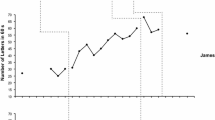Abstract
Written stories of normally achieving and learning disabled children in grades one through three were compared, using a Handwriting Evaluation Scale designed for this study. The subjects also were given tests for receptive language, figure copying and spelling. The Non-LD and LD groups differed on figure copying, spelling and written productivity, but not receptive language. The Non-LD grade level groups differed significantly on two components of the handwriting scale (Letter Size and Control), while the LD grade level groups differed on three components (Letter Formation, Alignment and Spacing, and Letter Size). The most pronounced differences between the LD and normally achieving children were on Formation and Size. A separate analysis of the third grade stories revealed that handwriting was less related to productivity than spelling and visual-motor skills. Nevertheless, the results indicated that many LD students have weak visual-spatial-motor skills. Implications for intervention are discussed.
Similar content being viewed by others
References
Alston, J. & Taylor, J. (1987). Handwriting: Theory, research and practice. New York: Nichols Publishing Company.
Bain, A. (1991). Handwriting disorders In: A. Bain, L. Bailet, & L. Moats (eds.), Written language disorders: Theory into practice (pp. 43–64). Austin, TX: Pro-Ed.
Beery, K. (1982). Developmental Test of Visual-Motor Integration. Cleveland, OH: Modern Curriculum Press.
de Ajuriaguerra, J. & Auzias, M. (1975). Preconditions for the development of writing in the child. In: E.H. Lenneberg & E. Lenneberg (eds.), Foundations of language development: A multidisciplinary approach, Vol. 2 (pp. 311–328). New York: Academic Press.
Dunn, L.M. & Dunn, L.M. (1981). Peabody Picture Vocabulary Test-Revised. Circle Pines, MN: American Guidance Service.
Frostig, M. & Horne, D. (1964). The Frostig program for the development of visual perception. Chicago, IL: Follett Publishing Company.
Furner, B.A. (1983). Developing handwriting ability: A perceptual learning process, Topics in Learning & Learning Disabilities 3: 41–54.
Gardner, H. (1980). Artful scribbles. New York: Basic Books.
Graham, S. (1986). The reliability, validity, and utility of three handwriting measurement procedures, Journal of Educational Research 79: 373–380.
Graham, S. & Miller, L. (1980). Handwriting research and practice: A unified approach, Focus on Exceptional Children 13(2): 1–16.
Grill, J. & Kirwin, M. (1989). Written Language Assessment (WLA). Novato, CA: Academic Therapy Publications.
Hamstra-Bletz, L. & Blote, A. (1993). A longitudinal study on dysgraphic handwriting in primary school, Journal of Learning Disabilities 26: 689–699.
Herrick, V. & Okada, N. (1963). The present scene: Practices in the teaching of handwriting in the United States. In: V. Herrick (ed.), New horizons for research in handwriting (pp. 17–32). Madison, WI: University of Wisconsin Press.
Johnson, D.J. (1987). Disorders of written language. In: D.J. Johnson & J.W. Blalock (eds.), Adults with learning disabilities: Clinical studies (pp. 173–204). Orlando, FL: Grune & Stratton.
Johnson, D. & Myklebust, H. (1967). Learning disabilities: Educational principles and practices. New York: Grune & Stratton.
Kellogg, R. (1969). Analyzing children's art. Palo Alto, CA: Mayfield Publishing.
Kephart, N. (1960). The slow learner in the classroom. Columbus, OH: Charles E. Merrill Books.
Larsen, S. & Hammill, D. (1989). Test of Legible Handwriting. Austin, TX: Pro-Ed.
MacArthur, C. & Graham, S. (1987). Learning disabled students' composing under three methods of text production: Handwriting, word processing, and dictation, The Journal of Special Education 21: 22–42.
Mann, P., Suiter, P. & McClung, R. (1979). Handbook in diagnostic-prescriptive teaching, Abridged, 2nd ed. Boston, MA: Allyn & Bacon.
Myklebust, H.R. (1965). Development and disorders of written language, Vol. 2 New York: Grune & Stratton.
Newcomer, P. & Barenbaum, E. (1991). The written composing ability of children with learning disabilities: A review of the literature from 1980 to 1990, Journal of Learning Disabilities 23: 578–593.
Newcomer, P., Nodine, B. & Barenbaum, E. (1988). Teaching writing to exceptional children: Reactions and recommendations. Exceptional Children 54: 559–564.
Orton, S. (1973). Reading, writing, and speech problems in children. New York: W.W. Norton.
Strauss, A. & Lehtinen, L. (1947). Psychopathology and education of the brain-injured child, Vol. 1. New York: Grune & Stratton.
Temple, C., Nathan, R. & Burris, N. (1982). The beginnings of writing Boston, MA: Allyn & Bacon.
Wechsler, D. (1981). Wechsler Adult Intelligence Scale-Revised. San Antonio, TX: The Psychological Corporation.
Wilkinson, G.S. (1993). Wide Range Achievement Test-3. Wilmington, DE: Jastak Associates.
Author information
Authors and Affiliations
Rights and permissions
About this article
Cite this article
Johnson, D.J., Carlisle, J.F. A study of handwriting in written stories of normal and learning disabled children. Read Writ 8, 45–59 (1996). https://doi.org/10.1007/BF00423924
Issue Date:
DOI: https://doi.org/10.1007/BF00423924




